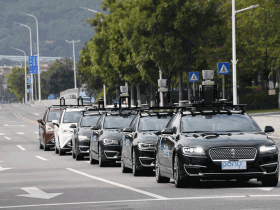Las Vegas
IN THE not-too-distant future you could ride one, two or three wheels… or maybe none at all.
Tech-inspired solutions for mobility – on land, air and water – featured prominently at the 2020 Consumer Electronics Show (CES) last week.
Some innovators played with long-established ideas like the bicycle or scooter by adding artificial intelligence, electric power and other technologies.
Autonomous and shared vehicles intended to curb traffic and emissions were front and centre.
Swiss-based group Rinspeed showed its latest “modular mobility” vehicle Metrosnap, which is built on a skateboard-like chassis and looks like a futuristic minibus. Different components can be swapped in to accommodate passengers, deliveries or even a mobile retail outlet.
Germany’s Bosch showed a similar autonomous shuttle bus-style vehicle that can offer “customised on-demand mobility”.
Juergen Reers, a mobility analyst with Accenture, said people are looking for flexible solutions.
“People want something more than (transit) where they are tied to rigid schedules and pickup stations,” he said.
Pedal power, with extras
Adaptations of the bicycle, infused with new tech for the connected generation, appeared at CES.
French startup Wello showed its open-sided, three-wheeled car-bike that relies on pedalling, electric power and solar panels on the roof, already in use by French postal services.
“It’s taking the best from the bicycle and the best from the car,” said Arnaud Chereau, co-founder of the group, which is based in Reunion Island in the Indian Ocean.
“It’s 100 per cent sustainable because it produces energy from the solar panels.” Also seen at the show was an off-road electric cargo bike from Sweden-based startup Cake, which riders can customise for various kinds of trips.
“You can commute to work, pick up your groceries and then grab your surfboard and head to the beach,” Cake spokesman Garin Fons said of the two-wheeler.
Another electric-assisted tricycle concept from Italian startup Measy adds another dimension: A cargo bay for a small delivery robot that can be set free to bring goods inside buildings.
“This is a concept for multimobility,” said Measy engineer Matta De Santis, demonstrating with a robot from fellow Italian startup Yape.
China-based Smacircle offered a simpler, lighter electric bicycle designed as two small, connected rings that fold up and fit a backpack or commuter case.
“If you take a train to work, you can use this for the first mile or last mile,” said Smacircle’s Darren Pike of the e-bike, which is only 53 centimetres high and weighs just over 10 kilos.
Some models presented a more outlandish way to get from A to B.
Ninebot Segway, which makes personal transporters and scooters, unveiled its S-Pod, a self-balancing armchair designed for urban streets.
“We are looking at different solutions for urban mobility,” said company spokesman Julie Tang.
According to Segway, the new personal transport pod can travel up to 39 kilometers an hour and is designed with intuitive controls to avoid tipping over.
New Zealand startup Manta5 presented its water bike, which also uses electricity.
The Manta5 hydrofoiler, with variable electric power assistance, is “a new category of water sport” that is quiet, environmentally friendly and allows you “to see directly into the water”, spokesman Louis Wilks said.
Some CES exhibitors said the best way to cope with traffic on the ground is to rise above it.
Aeronext unveiled a scaled-down model of its “flying gondola” designed as a personal transporter. The gondola uses so-called “4D gravity” to keep the passenger compartment stable even during turbulence.
“This is original technology. Conventional air mobility drones are not stable,” said Keisuke Toji, chief executive of the group, which has offices in Japan and China.
South Korea’s Hyundai meanwhile announced it would begin mass-producing flying cars for Uber, moving the idea of aerial robo-taxis closer to reality.
Putting it all together
The vast array of new transport options could lead to a more sustainable future, but only if coordinated, said Accenture’s Mr Reers.
Hyundai proposed a network of hubs to connect various forms of personal and mass transit with stations for its drones.
Toyota said it would create a “woven city” in Japan, powered by hydrogen fuel cells, where it would test autonomous driving and related technologies.
At the moment, Mr Reers said cities have resisted new modes of transport like scooters because they don’t fit into the ecosystem, highlighting the need for better planning.
“These new developments create huge opportunities to manage the system in a more sustainable way,” he said. AFP















